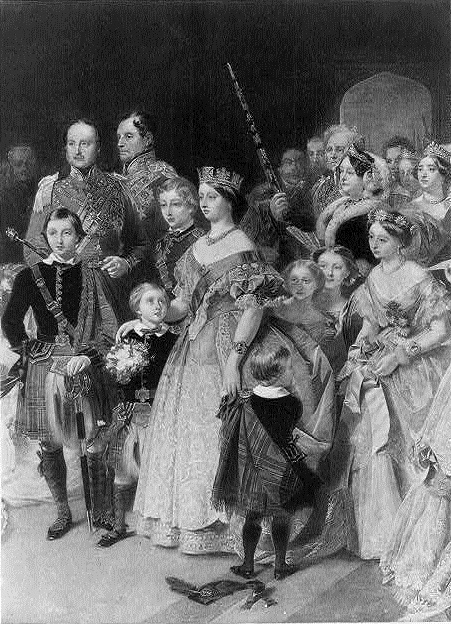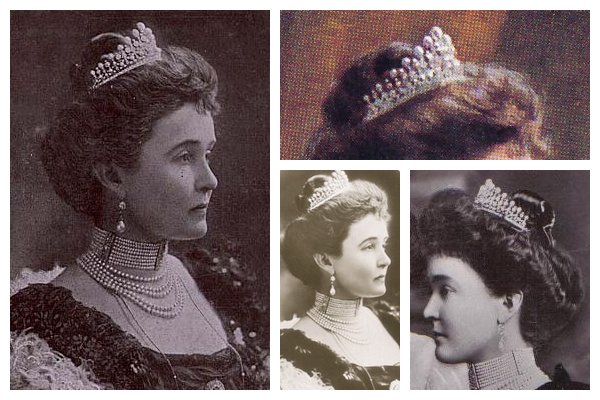For Canada’s 2013 Victoria Day, A Small Dedication to Queen Victoria, with Reflections on Her Majesty by Ismaili Imams
Post compiled by Malik Merchant,
Editor, Simergphotos.com and Simerg.com
Introduction: Victoria Day is a federal Canadian public holiday celebrated on the last Monday before May 25, in honour of Queen Victoria’s birthday. Queen Victoria was born on May 24, 1819. Following the death of three uncles and her father, she became Queen of the United Kingdom on June 20, 1837 and reigned for 63 years until her death on January 22, 1901. Queen Victoria is still the longest-reigning monarch of the United Kingdom.

Queen Victoria officially chose Ottawa as Canada’s capital in 1857. Nearly forty years later, a monument to Queen Victoria, intended as part of a lavish celebration of the Queen’s Diamond Jubilee, the sixtieth year of her reign, was proposed for the Hill. The competition for this monument was only open to Canadian sculptors. Louis-Philippe Hébert, a sculptor from Quebec, won the contract. Before being placed on Parliament Hill, the statue was first displayed at the Universal Exposition in Paris in 1900.
THE AGA KHANS AND THE BRITISH MONARCHY

His Highness the Aga Khan received the title “His Highness” from Britain’s Queen Elizabeth II on July 26th 1957. Here he is pictured with Her Majesty the Queen and His Royal Highness Prince Philip when the Queen hosted a dinner hosted to mark the Ismaili Imam’s Golden Jubilee and to acknowledge the close relationship he and his family have had over generations with the British Monarchy and the UK. See quotes below. Photo Credit: Akdn.org
QUOTES BY THE 48TH AND 49TH ISMAILI IMAMS
– I –
Over a century ago, my grandfather, Sir Sultan Mahomed Shah Aga Khan, worked closely with Her Majesty Queen Victoria and her governments in the pursuit of common ideals. These ties were further strengthened by the strong presence of the Ismaili community – initially in places which later became Commonwealth countries, and later, here in the United Kingdom.
It is striking to me that in 1957, there were only about 100 Ismaili residents in this country, and most of them were students. Today, there are fourteen thousand Ismailis permanently living here and of all ages and walks of life.
In 1957, there was only one Ismaili space here for congregational prayer – and that was on leased premises! Creating places of prayer as centres for community life was fundamental to ensuring the cohesion of the community, and there are now over 40 such places. Among them, of course, a central focal point is The Ismaili Centre, located in South Kensington.
All of these comments, then, speak to the context in which we gather tonight – a rich history of partnership reaching deeply into the past – and extending, we hope and trust, into an even more productive future….Excerpts from a speech by His Highness the Aga Khan at the Golden Jubilee Banquet in London, UK, July 3, 2008.

His Highness the Aga Khan III by Dorothy Wilding. Copyright: The National Portrait Gallery
– II –
My life in many ways has been a bridge across vastly differing epochs. Looking at it for the moment simply from the Western point of view — I had a full life in the Victorian era, and I am leading now an equally full life in this new Elizabethan era. When I was a young man I sat next to Queen Victoria at a dinner party and talked to her throughout it; the other day I sat next to Queen Elizabeth II at a tea party and talked to her throughout it.
In my youth the internal combustion engine was in its early, experimental phase, and the first motor cars were objects of ridicule; now we all take supersonic jet propulsion for granted, and interplanetary travel is far more seriously discussed today than was even the smallest flying venture at a time when I was quite grown up and had already lived a full and active life. I had the great honor of knowing Lord Kelvin, in his time the greatest physicist in the world; he assured me solemnly and deliberately that flying was a physical impossibility for human beings and quite unattainable. Even H. G. Wells in his early book, Anticipations, put off the conquest of the air and the discovery of atomic power for two or three centuries. Yet these and much more have come to pass in a brief half century — His Highness the Aga Khan III, writing in Memoirs of Aga Khan, 1954.
– III –
Queen Victoria herself was of course sharply conscious of the responsibilities, not only political but personal and social, which she had assumed with the splendid title of Empress of India. She insisted that Indian Princes and Indian gentlefolk should receive the respect and the dignified status accorded in those days to European princes and gentlefolk. The Duke of Connaught faithfully practiced her principles during his time in India. The Viceroy and Vicereine, Lord and Lady Dufferin, were, like Lord and Lady Reay, people of kind and gentle sensibility, warm hearts and graceful manners. A tone thus set could not be ignored, and Indo-British relationships in general were in this pattern.
There is an outstanding example that I recall: Sir Jamsetjee Jeejeebhoy, a notable figure in the Parsee community in Bombay, gave a reception for the Viceroy and Vicereine, Lord and Lady Dufferin, for the Governor of Bombay and his wife, Lord and Lady Reay, and for the Duke and Duchess of Connaught. Sir Jeejeebhoy, as host, offered his arm to Lady Dufferin and went into the supper room, and the Viceroy followed with his hostess, Lady Jeejeebhoy, and everyone else went after in turn. A few years later -and thereafter, until the end of the Indian Empire — it would have been inconceivable that the Viceroy, a Prince of the British Royal House and the Governor of the great province of British India, would have gone to a reception at the house of a Parsee gentleman, however distinguished, and allowed him to lead the Vicereine in first and then have followed with his hostess. — His Highness the Aga Khan III, writing in Memoirs of Aga Khan, 1954
article continues after photos….
HISTORICAL PHOTOS FROM THE US LIBRARY OF CONGRESS

Queen Victoria and family. Copyrighted by Boussod Valadon & Co. Painting by John Philip. Date created/published c.1897. Credit: US Library of Congress Collection

A telegraphic message of Queen Victoria and a reply by US President James Buchanan by trans-Atlantic telegraph cable on 16 August 1858. The Queen’s message congratulates the President for the completion of an electrical cable between the two nations, and wishes prosperity for the United States. In response, President Buchanan says that the accomplishment “is a triumph more glorious, because far more useful for mankind, than was ever won by a conqueror on the battlefield.” He continues, “May the Atlantic Telegraph under the Blessings of Heaven prove to be a bond of perpetual peace and friendship between the kindred nations, and an instrument destined by Divine Providence to diffuse religion, civilization, liberty and law throughout the world.” Date work created/published: 1858. Medium: 1 print : wood engraving. With vignette busts of the principals and scenes of the event; also inscribed are the names of 4 men who made the even possible: [Benj.] “Franklin”, [S.F.B.] “Morse”, [Cyrus] “Field”, and [Hans Christian] “Oersted”.
– IV –
The first deep impression of my life was undoubtedly when I had dinner with Queen Victoria. I was in my 20th year and that was my first visit to London. The queen was fond of Indian potentates and she kindly invited out to Windsor to dine and spend the night. She placed me next to her at the table. The queen was most gracious. She arranged that the food was served by Indians, and she spoke to me about the problems of India, the plague and all that. She was especially interested in the plague. I was young and I was particularly interested by her human element. She was then 79, you know, and the dinner was very long, with three sweet courses at the end, but she ate everything. She was dressed in black, with a white-collar. She wore a huge bracelet having a medallion of her husband, Prince Albert, on it, and one large diamond ring and several smaller diamonds. She did not wear glasses but she saw clearly and she had beautiful hearing — she could hear a whisper. She was a remarkable woman — yes, undoubtedly, I must be one of the few left alive who have dined with her — His Highness the Aga Khan, quoted in Life Magazine, May 16, 1949.
HIS HIGHNESS THE AGA KHAN’S GIFT TO QUEEN VICTORIA

All photos: Princess Louise, Duchess of Connaught and Strathearn
In 1896, a year before her Diamond Jubilee, an inventory of Queen Victoria’s jewels was made by Garrard, the crown jeweler There weren’t many tiaras on the list — only five. But one of the five on the list was this one: the tiara given to her by the Aga Khan.
The inventory describes the tiara as “A pearl and diamond tiara with 12 Bouton and 12 pear-shaped pearls with a diamond chain to form a necklace, presented by Aga Khan.”
To my knowledge, there are no images, painted or photographed, of Victoria in this tiara. However, we do know that Victoria bequeathed the tiara to one of her daughters-in-law: Princess Louise of Prussia, the wife of Prince Arthur, Duke of Connaught and Strathearn — Elia Kay writing in her blog Tiara a Day, please click The Victorian Aga Khan Tiara.
________________
For a complete list as well as links to photo essays published on this blog please visit the Home Page or click on Table of Contents.
We welcome feedback/letters from our readers. Please use the LEAVE A REPLY box which appears below or send your letter to simerg@aol.com. Your feedback may be edited for length and brevity, and is subject to moderation. We are unable to acknowledge unpublished letters.
Great photos, some hard to find Victorian ones. Good work.
Excellent material Malik, and great photos. You are doing a fine job. Keep it up.
Ya Ali Madad
I know this site is open to all, yet I have to say I didn’t like the photo of the the 48th Imam, it is just a studio portrait and it is difficult for us as Ismailis to identify with. I expect people will differ!
Good photos! Thank you for sharing.